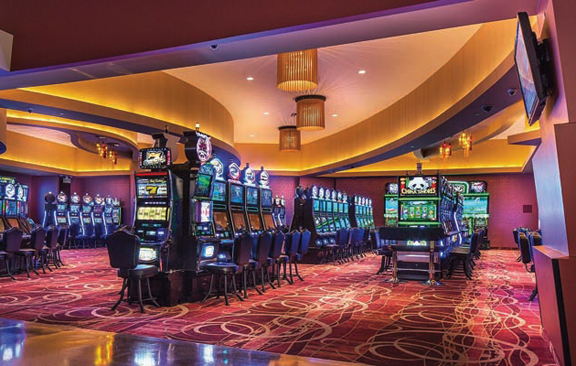
Morongo Casino Resort & Spa in Cabazon, California added 30,000 square feet, which enabled the expansion of its gaming floor by 30 percent
Pressure eases off the brake pedal. Slowly but surely, the pandemic that shut down gaming has less force.
Operators await business beyond Covid-19. And tribal properties, like their commercial colleagues, will benefit from those who innovate ahead of the post-pandemic curve.
Casinos are already placing social distances and guest separation into their plans to gain an edge for the future. Sharp vendors serving tribal gaming interests are both anticipating and reacting to market needs.
“The reality is that gaming is one of the most resilient industries on the planet,” says Nick Schoenfeldt, vice president and principal of Thalden Boyd Emery Architects. “We’ve weathered social, economic and health crises for years and come out stronger and more profitable.
“The current pandemic will eventually come to an end, and many casinos will return as though 2020 never happened.”
Building Outside the Box
HBG Design has a long, storied presence in tribal gaming. Principal Dike Bacon says the company has worked with more than 40 sovereign nations across the United States, bringing their strategic visions to life through the design of award-winning casino resorts.
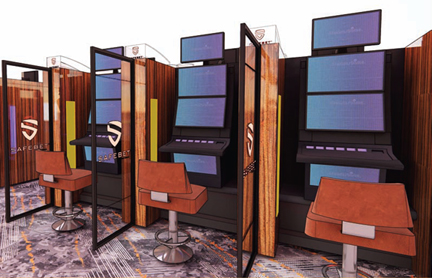
HBG’s SafeBet gaming pods offer social distancing and a patentpending UVC Breathing Zone that kills 99.99 percent of airborne pathogens
Along that journey, the company took a game-changing side trip in the past couple of years. Its innovative SafeBet product allows properties to continue to operate amid Covid-19. The concept of SafeBet can also spread to other industries.
“As creative people and problem-solvers, it’s in our DNA to design with the intention of making places and spaces better,” says Bacon. “That’s fueled the creation of our SafeBet slot pods, which HBG designed in 2020 and is patenting. We’re now manufacturing SafeBet through our partnership with KGM Gaming.”
The pods offer social distancing “with additional layers of comfort and personal space,” says Bacon. “SafeBet literally creates the safest seat on the gaming floor, with the only personalized ventilation system available in the market today.” Its patent-pending UVC Breathing Zone kills 99.99 percent of airborne pathogens and bacteria.
“Think of it like this: As a guest in a casino, playing at a slot machine that has the SafeBet product, you essentially have a personal ventilation cleaning system working for you and killing pathogens in the air immediately around the you while you play,” says Bacon. “It’s a win-win for owners and their guest… What we’re doing with SafeBet is providing a path for owners to maximize floor space and push revenues higher, while offering the kind of protection that provides guests with peace of mind.”
The breakthrough product was part of HBG’s multiple-faceted approach to the crippling pandemic.
“One of the biggest takeaways from Covid in our industry is the focus on making cleanliness, safety and wellness top priorities,” Bacon says. “The perception of cleanliness is paramount in bolstering a positive feeling of safety and well-being among guests, but the measures operators take have to work.”
Bacon says current design projects show better utilization of interior and exterior spaces, blurring the lines to bring the outdoors in and the indoors out. This is especially true in food and beverage, in which seating capacities can be increased with little to no new square footage. Designers are rethinking how to seat and serve guests to achieve social distancing, and compartmentalizing spaces in a natural, fluid manner.
“We’ve been analyzing and re-purposing existing space—often square footage that’s underutilized or, in some instances, unused, in the casino,” says Bacon. “We’re weaving design- and facility-planning principles with emerging technologies to develop responsive design solutions.”
Beyond safety breakthroughs, HBG retains a presence as an industry heavy-hitter, ranking among the Top 5 hospitality design firms in the country for more than a decade, according to Bacon.
“We’re one of only a handful of design firms working in the tribal sector that’s laser-focused on hospitality and entertainment design as the core of what we do, and that’s a real differentiator,” Bacon says.
Many of the firm’s Indian gaming clients continued to pursue projects during and despite Covid-19, both on the design side and in new construction. The prevailing attitude was that the calendar doesn’t stop, and lost time is lost revenue.
Two projects opened recently: the 1.2 million-square-foot Desert Diamond West Valley Resort in Glendale, Arizona, and the $180 million, 459-room, Four Diamond hotel expansion at Cache Creek Casino Resort in Brooks, California, outside Sacramento.
In addition to gaming, both projects include a diverse range of non-gaming amenities targeted to each region’s specific market and guest demographic.
An Optimistic Outlook
Thalden Boyd Emery Architects views the pandemic as an obstacle to be overcome, and Schoenfeldt expresses one of the most optimistic viewpoints in the gaming industry.
“The Covid pandemic completely shook the casino gaming and hospitality industry,” he says. “Almost overnight, the global mindset became laser-focused on sanitization and separation. And when the doors finally started to open, we noticed a lot of changes.”
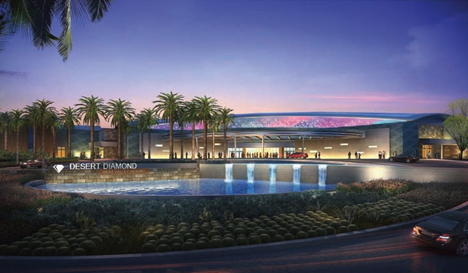
Completion of the Desert Diamond West Casino in Glendale, Arizona proceeded despite the Covid-19 pandemic
Some of those changes will likely remain. TBE expects that many casinos will retain Plexiglas as a permanent, decorative/advertising element between machines and in other select areas. Hand-sanitizing stations will probably stick around, too.
“As for the amenities, the pandemic really opened the industry’s eyes to the reality of F&B,” Schoenfeldt says. “While it’s still an important amenity in maintaining a balanced offering, we see the food-hall concept taking on a more dominant position over the traditional buffet.”
With reduced capacity on casino floors, some operators have temporarily converted ballrooms, F&B areas and neutral spaces to gaming. “Going forward, we’re already seeing casinos looking to allocate more square footage to the game floor, creating a less crowded feel compared to the pre-Covid times, but not so much that players feel isolated,” says Schoenfeldt.
During the pandemic year, TBE continued to service three construction projects with three of its most loyal clients, and within the last eight months completed and opened three tribal projects. The most recent was a $97 million project for the Tulalip Tribes in Tulalip, Washington.
The Quil Ceda Creek Casino spans more than 120,000 square feet with 1,500 gaming machines (an increase of 500 machines), 16 table games (with three new tables added), an expanded entertainment lounge, three full-service bars, a full-service restaurant, a food hall with multiple cooked-to-order food venues and a state-of-the-art smoke-management system.
A new six-story parking garage includes more than 1,000 parking stalls, along with elevators and enhanced accessibility for guests with disabilities. Additional surface parking and charging stations for electric vehicles are conveniently located near the casino entrances. The new Quil Ceda Creek Casino has approximately 700 more parking spaces than the previous location.
And last October, TBE unfurled the $125 million We-Ko-Pa Casino Resort in Fort McDowell, Arizona for the Fort McDowell Yavapai Nation. The new resort raised the bar for gaming venues in the Northeast Valley. It offers a full complement of slot machines, tables, bingo and gaming amenities, along with a separate poker room and two blackjack pits.
The new casino also includes a wide variety of dining establishments, event venues, Native American design elements and other features designed to maximize the comfort, safety and enjoyment of all who visit the casino or stay at the adjoining 246-room AAA Four Diamond hotel.
All gaming areas, hotel rooms and public spaces, dining facilities and entertainment venues are 100 percent smoke-free (there are four outdoor lounges designated for smokers).
The facility also is in full compliance with Covid-19 mandates. The virus was unknown at the time construction began, but the Yavapai Nation has made “substantial” investment in integrating features that bring it into compliance with medical safety standards. The 166,341-square-foot casino, designed for 900 slot machines, opened with 700 divided by Plexiglas screens.
Last September, TBE completed a $26.4 million project at the Wildhorse Resort & Casino for the Confederated Tribes of the Umatilla Indian Reservation in Pendleton, Oregon.
The new family entertainment center at Wildhorse Resort brings with it 24 lanes of bowling, a new three-venue food court, and a state-of-the-art arcade. The capstone of the addition, the bowling center, has room for open play and league play as well as eight “boutique” lanes that can be reserved for parties and private events.
These two areas are separated by a soaring clearstory space allowing an abundance of sunlight into the space. Custom light fixtures recall the thundering hooves of wild herds of horses that traversed these high plains centuries ago. Geometric patterns and colors represent the unique character of the history of the indigenous peoples and organic rolling hills of the region.
Out In Front of Change
“Even before Covid, the casino floor was changing, becoming less congested and more flexible,” says John Hinton, director of Native American projects for Bergman Walls Associates.
“This shift was catalyzed by the advent of interactive and alternative gaming that was already changing the gaming experience, and the way casino floor design was being approached.”
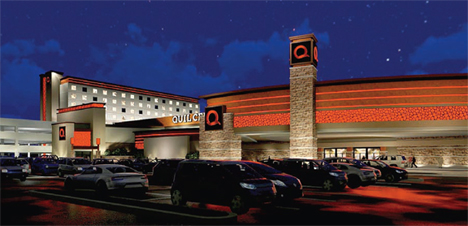
The 120,000-square-foot Quil Ceda Creek Casino in Tulalip, Washington includes more than with 1,500 gaming machines, 16 table games and a state-of-the-art smoke management system
As a result, prior to the virus, some operators were already preparing to reconfigure their floors. They adapted to “the short-term pandemic reality,” says Hinton, “while at the same time thinking about post-pandemic renovations in an already-changing gaming landscape.
“The need for social distancing has helped our clients and us see possibilities in their existing venues,” he adds. “For example, to create more space on gaming floors, currently underutilized spaces such as event and conference rooms now contain slot machines and gaming tables. This has our clients thinking about how they can make spaces more flexible and scalable in the future.”
The approach is the same for both tribal and non-tribal casino operators. It’s about creating distance to keep customers safe, while maintaining their connection to the guest experience.
Hinton says operators can’t have Plexiglas dividers between patrons indefinitely, but can reimagine floor layouts for machines and game tables and move some to underutilized space elsewhere.
Reducing touchpoints is vital. Personal cellphones can be used for everything from room check-in and keyless entry to automated food ordering and even as a TV remote control in guest rooms. Buffets will be staffed with servers instead of being self-serve, or else be replaced with food halls with distanced communal dining.
Many of these changes were being considered or were already under way when the pandemic hit; the outbreak naturally hastened their implementation. Based on their locations, some tribal casinos have the flexibility to add more outdoor dining, entertainment and recreation opportunities, offering socially distanced options that attract a wider variety of audiences.
Here are some of BWA’s recent noteworthy projects:
Morongo Casino Resort & Spa, Cabazon, California (Morongo Band of Cahuilla Mission Indians): This renovation project included a 65,000-square-foot expansion that increased the size of the gaming floor by 30 percent, added new slots and table games and included a number of new bars and restaurants. BWA completed the project in conjunction with Kenneth Ussenko Design of Santa Ana, California.
Swinomish Casino & Lodge, Anacortes, Washington (Swinomish Tribe): This project involved remodeling and expanding the existing hotel tower as well as the casino floor to improve sightlines and gaming options. It added convention space and new retail and dining options. BWA also added a larger kitchen and increased back-of-house areas. In its design, BWA also took advantage of the breathtaking views of the Swinomish Channel to the east and Padilla Bay, San Juan Islands and Mount Baker to the north.
Apache Casino Hotel, Lawton, Oklahoma (Fort Sill Apache Tribe): This renovation project involved enclosing the gaming tent with a permanent structure, adding restaurants and a players club, and creating a master plan in which the design team identified ways to improve the guest experience and define the phases of work. BWA also designed a new 53,000-square-foot event center that features themes inspired by tribal history and the local countryside. The center can be configured as a 1,200-seat showroom, ensuring no guest is more than 100 feet from the stage, and is easily divisible for smaller events. Four large VIP suites provide additional functionality.
Snoqualmie Casino, King County, Washington (Snoqualmie Tribe): BWA worked with the tribe to realize its vision of creating a great lodge with a fun and exciting atmosphere. Along with 11,500 square feet of convention space, the property features a 50,000-square-foot casino and a 1,000-square-foot retail quarter with a Northwest flavor both inside and out.
Besides safety and innovation, BWA has an eye toward the next generation of customers, says Hinton.
“Casino gaming has always been challenged to find ways to attract different and younger patrons; Covid both gave facility operators the chance to step back and examine their long-term plans, and accelerated the process for putting plans into place,” he says.
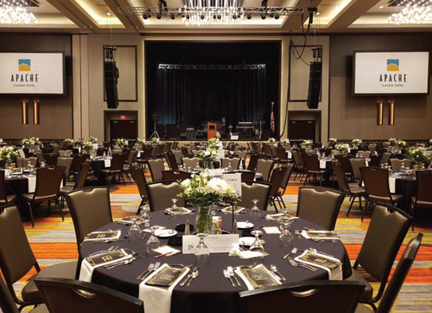
The new event center at the Apache Casino Hotel in Lawton, Oklahoma is easily divisible for large and small gatherings, with social distancing easily managed
For both tribal and non-tribal gaming clients, sports betting was already impacting facility design pre-Covid. The sports bettor is a different customer than the traditional casino patron, so there must be amenities that draw them to your venue.
Sports-betting lounges have interactive kiosks, wide screens for watching the game and communal spaces to gather with other bettors. Even though the wagers can be placed remotely, these are places guests want to be. It’s also a great mechanism for getting younger patrons to a venue, so they can see what else is on offer, plan a spa trip, see a show or have dinner.
In terms of entertainment spaces, tribal clients are looking to smaller performing arts venues that can attract more affordable regional and mid-level talent. Having to sell out a venue to cover the costs of big-name entertainers is more challenging now, and may stay that way for the foreseeable future.
Outdoor entertainment spaces such as bars, nightclubs and poolside activities are helping to mitigate short-term indoor gathering concerns, while creating some appealing long-term options at the same time.
Welcome to the Show
Forget about the inefficiencies of large firms and the constraints of small ones. It’s time for creativity on a grand scale.
That’s the theme emanating from Campbell House founder Beth Campbell, who launched her own design company in January.
As the former CEO of Wilson Associates, a top global interior design firm, Campbell has overseen the design of iconic projects for more than 30 years. Campbell House is a full-service interior design firm with studios in Las Vegas, Los Angeles, Dallas and New York.
“We’re a brand-new company, made up of experienced design veterans,” says Jennie Bowman, chief marketing officer. According to the company’s website, Campbell House is “focused on high-engagement design solutions for hospitality, gaming, entertainment, restaurants and corporate workplace,” Campbell House “openly and unapologetically puts their people and culture first. Bringing to bear the best talent to support their client’s needs, regardless of location, we deliver engagement design in an era of meaning and purpose.”
Creative Director and Principal Joyce Lynn Lagula says the company serves an industry that’s already flexible.
“Casinos typically work on the model of a flexible gaming floor anyway, so the pandemic hasn’t fundamentally changed or dictated any key aspect of how they’re designed,” she observes. “Safety measures that were put in place for them during the pandemic, such as acrylic dividers and every-other-slot-machine-on could be considered temporary and a setup in survival mode.
“But there’s been some positive feedback on certain types of slot layouts from guests and operators alike, where appropriate distance can be achieved while maintaining a great gaming environment. For example, take a three- or five-slot carousel setup, as opposed to four to six machines in a row.”
Lagula believes the major difference and advantage for tribal casinos over non-tribal properties is their reach and approachability for guests during a cautious time like the pandemic. Tribal casinos have more a more regional base; when trust is paramount, their direct connection to their communities comes into play. Design can help support that.
According to Lagula, some approaches that stemmed from the pandemic in the gaming industry overall are really focused on integrating technology into the experience, whether it’s through QR-code marketing as a draw for patrons or creating spaces that, while differently configured, still achieve connect with guests.
“That’s what we lean on as designers, creating stronger connections with guests and the space through powerful design,” says Lagula. “That’s something the pandemic took away from us in 2020.”
For some in the industry, the pandemic left a new mark. For others, it merely brought an existing mark into clear focus. Either way, the race is on to bring tribal communities and gaming as a whole back to full speed.






